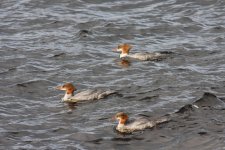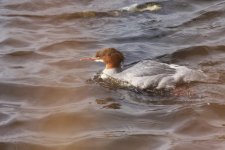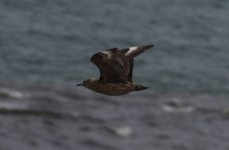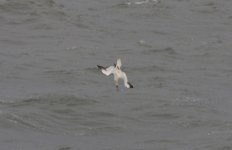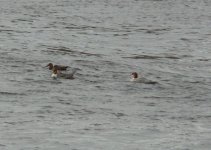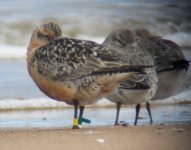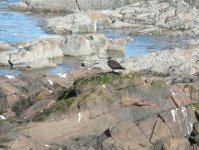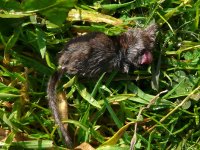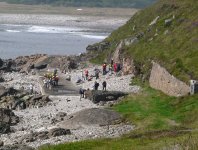-
Welcome to BirdForum, the internet's largest birding community with thousands of members from all over the world. The forums are dedicated to wild birds, birding, binoculars and equipment and all that goes with it.
Please register for an account to take part in the discussions in the forum, post your pictures in the gallery and more.
You are using an out of date browser. It may not display this or other websites correctly.
You should upgrade or use an alternative browser.
You should upgrade or use an alternative browser.
Birds fae Torry (2 Viewers)
- Thread starter Andrew Whitehouse
- Start date
More options
Who Replied?
Had a nice walk around the Ness tonight,with my friend Doug.On the Bay of Nigg,were 2 adult and 2 Juvenile Ringed Plover and 5 summer plumaged Sanderling.
On Greyhope Bay 100+ Sandwich Terns on the rocks,including many Juvenile birds.A total of 51 Goosander were counted between the 3 Piers and a female Sparrowhawk,keeping an eye of the Starlings coming in to roost.
On Greyhope Bay 100+ Sandwich Terns on the rocks,including many Juvenile birds.A total of 51 Goosander were counted between the 3 Piers and a female Sparrowhawk,keeping an eye of the Starlings coming in to roost.
Joseph N
Lothian Young Birder
Due to the recent seabird passage in the UK and the weather today here in Aberdeen, I decided that it seemed like a good idea to head down to the Ness this evening for a bit of sea-watching. As I expected, it was quite lively offshore. Gannets were passing offshore constantly, some far out and some very close in, with well over 100 birds noted in the hour and a half or so that we sea-watched off the Coo. Of more interest Skua passage was fairly evident, with totals of 5 Great Skuas and 3 Arctic Skuas respectively - not exactly very good, but notable. Kittiwakes and Fulmars were also passing frequently, and a group of 7 Common Scoters were noted late on. Conspicuous by their absence were any shearwaters, and I was very surprised that none were passing despite the skua passage. Its about time that the Aberdeenshire coast and Girdleness had some Sooty Shearwater sightings. They're being reported all the way down the east coast of the UK, yet here we've had hardly any. I'm sure things will liven up shearwater wise soon, though. 
I didn't have time to check the rest of the Ness, but it was nice to see the Goosanders in the harbour (a total of 14), especially so close.... A Great Skua very close in off the foghorn was a treat too, as was a very close in diving Gannet.
Joseph (The photos were taken with my new Canon 400mm lens and Canon EOS 40D camera)
I didn't have time to check the rest of the Ness, but it was nice to see the Goosanders in the harbour (a total of 14), especially so close.... A Great Skua very close in off the foghorn was a treat too, as was a very close in diving Gannet.
Joseph (The photos were taken with my new Canon 400mm lens and Canon EOS 40D camera)
Attachments
Last edited:

Meanwhile, back in Torry...
This evening I had my first proper look round Girdle Ness for quite a while (must have just missed you Joseph). I was sort of vaguely hoping for some decent seabird action and, well, it wasn't really that exciting given the decent weather conditions. But there were one or two bits and bobs around.
I also noticed plenty of Goosander - at least 38 in fact. Not troubling the totaliser (thanks to Ben for holding the fort there) but this may have been an underestimate as birds were moving around quite a bit (and even flying, a bit surprisingly). Earlier in the week I saw a couple of drakes upstream of the Victoria Bridge too. Most intriguingly, amongst the Goosander was some serious patch scarce in the form of a female Shoveler (see splendid picture). Not one I've seen at all often here. A single Wheatear was on the north shore.
There were lots of sorts on Greyhope Bay: four Knot, a Sanderling, two Dunlin, three Turnstone and eight Ringed Plover. One of the Knot was colour-ringed, I think from a Dutch scheme. I shall try to find out more.
There were seabirds moving, but not in large numbers. I've seen one or two Arctic Skuas from the flat over the past couple of days and while I was watching around eight or nine went through. It was difficult to be sure of the exact numbers as they were often loitering, very much with 'intent' I would say. Also at least six Bonxies north, some quite close. I did manage some shearwaters but just two Manx. Sooty numbers actually seem to be pretty low in the North Sea but I reckon we ought to be able to pick up one or two over the weekend. Keep 'em peeled. Otherwise just a steady stream of Gannets, Kittiwakes and Fulmars and small numbers of Sandwich and Common Terns. One juvenile Arctic Tern went north. Also one Harbour Porpoise. A couple of Bottlenose Dolphins were in the harbour earlier in the day.
Walking along the south side, I was startled to watch a Sparrowhawk pluck a Meadow Pipit out of the air from right in front of me. It headed off to the golf course to find some peace to have its evening meal.
The only other development was the appearance of a fairly substantial piece of carpet in Walker Park. Not sure what that's to do with.
This evening I had my first proper look round Girdle Ness for quite a while (must have just missed you Joseph). I was sort of vaguely hoping for some decent seabird action and, well, it wasn't really that exciting given the decent weather conditions. But there were one or two bits and bobs around.
I also noticed plenty of Goosander - at least 38 in fact. Not troubling the totaliser (thanks to Ben for holding the fort there) but this may have been an underestimate as birds were moving around quite a bit (and even flying, a bit surprisingly). Earlier in the week I saw a couple of drakes upstream of the Victoria Bridge too. Most intriguingly, amongst the Goosander was some serious patch scarce in the form of a female Shoveler (see splendid picture). Not one I've seen at all often here. A single Wheatear was on the north shore.
There were lots of sorts on Greyhope Bay: four Knot, a Sanderling, two Dunlin, three Turnstone and eight Ringed Plover. One of the Knot was colour-ringed, I think from a Dutch scheme. I shall try to find out more.
There were seabirds moving, but not in large numbers. I've seen one or two Arctic Skuas from the flat over the past couple of days and while I was watching around eight or nine went through. It was difficult to be sure of the exact numbers as they were often loitering, very much with 'intent' I would say. Also at least six Bonxies north, some quite close. I did manage some shearwaters but just two Manx. Sooty numbers actually seem to be pretty low in the North Sea but I reckon we ought to be able to pick up one or two over the weekend. Keep 'em peeled. Otherwise just a steady stream of Gannets, Kittiwakes and Fulmars and small numbers of Sandwich and Common Terns. One juvenile Arctic Tern went north. Also one Harbour Porpoise. A couple of Bottlenose Dolphins were in the harbour earlier in the day.
Walking along the south side, I was startled to watch a Sparrowhawk pluck a Meadow Pipit out of the air from right in front of me. It headed off to the golf course to find some peace to have its evening meal.
The only other development was the appearance of a fairly substantial piece of carpet in Walker Park. Not sure what that's to do with.
Attachments
Joseph N
Lothian Young Birder
Nice photos Joseph.I look forward to seeing more of your photos,now you have your new camera.
Thank you Ben, I will no doubt be posting more photos on this thread and on the Wild in Aberdeen thread in the near future. I'm really enjoying using my camera and lens, and will no doubt enjoy photographing some lovely birds in the future.
We did indeed miss each other Andrew but not by long I don't suppose. Glad to see you that you saw a couple of Manxies and experienced the same skua passage as I did today. I have to agree that this weekend there should be a few Sooties passing through the Aberdeenshire coast, it's just a case of them being seen. I am going to be getting out tomorrow and will no doubt be doing a bit of seawatching, so will keep my eyes peeled. :t:
Last edited:
Hi Joseph, glad to see you are enjoying your photography. Your photos are pretty good too! I hope you don't mind if I make a suggestion. Your shutter speed of 1/500 sec is really way too slow for birds in flight, or birds in dive. You would obtain a faster speed if you used the camera in aperture priority mode (av) set at around f5.6, and if necessary increase the ISO rating to maybe 400. Then as long as you are able to focus accurately on the bird, all should be well, and you will have a sharper image. There are lots of threads here on BF dealing with the subject, well worth studying. The 400L is a great lens, an excellent choice.

Had a sneak round the Ness again this evening. 'Interesting' again, but not really thrilling. We do at least have some movement on the Goosander totaliser:
53
Fine work there. Other bits of counting producecd 54 Turnstones on the Skate's Nose and a single Knot on Greyhope Bay. More unusual from a Ness perspective was a single Bar-tailed Godwit roosting with the Turnstones. A Sparrowhawk was bothering the Swallows on Abbey Road.
I seawatched for about an hour in almost no wind at all. Unlike yesterday there was a fairly good passage of Manx Shearwaters with 40 going north. Other shearwaters were 'elusive'. Also six Arctic Skuas, four Bonxies, 17 Common Scoter and a Red-throated Diver.
53
Fine work there. Other bits of counting producecd 54 Turnstones on the Skate's Nose and a single Knot on Greyhope Bay. More unusual from a Ness perspective was a single Bar-tailed Godwit roosting with the Turnstones. A Sparrowhawk was bothering the Swallows on Abbey Road.
I seawatched for about an hour in almost no wind at all. Unlike yesterday there was a fairly good passage of Manx Shearwaters with 40 going north. Other shearwaters were 'elusive'. Also six Arctic Skuas, four Bonxies, 17 Common Scoter and a Red-throated Diver.
Joseph N
Lothian Young Birder
Hi Joseph, glad to see you are enjoying your photography. Your photos are pretty good too! I hope you don't mind if I make a suggestion. Your shutter speed of 1/500 sec is really way too slow for birds in flight, or birds in dive. You would obtain a faster speed if you used the camera in aperture priority mode (av) set at around f5.6, and if necessary increase the ISO rating to maybe 400. Then as long as you are able to focus accurately on the bird, all should be well, and you will have a sharper image. There are lots of threads here on BF dealing with the subject, well worth studying. The 400L is a great lens, an excellent choice.
Hello Ken, thank you very much for complimenting my photos, it is much appreciated, and yes I agree it is an excellent choice! And its absolutely fine that you have given me that suggestion, as a newbie to photography this is very useful information to know! I have basically kept all settings on Full Auto and Basic Zone Modes, so haven't used the Creative Zone. I will do as you say in the near future though, thank you for the advice!
And Andrew, glad to see you got some Shearwater passage. I did too down at Battery Park mid-morning. You told me to keep 'em (the eyes of course) peeled for Sooty Shearwater, and I was lucky enough to have 4 off Battery Park today, lovely birds to see and very rewarding. I had about 15 Manxies there, and a slightly more substantial skua passage (10 Bonxies and 6 Arctic). I believe there was similar numbers of manxies and skuas off Newtonhill today, as well as a couple of Sooties. Good to see sea-watching picking up a little. :t:
Joseph
nicklittlewood
Well-known member
One of the Knot was colour-ringed, I think from a Dutch scheme. I shall try to find out more.
Hi Andrew,
This same bird was at Blackdog yesterday - the scheme organiser sent me the details together with your sighting listed. It was ringed in Netherlands in February 2008 and these sightings these last few days are the first since then. Photo below,
Nick
Attachments

Hi Andrew,
This same bird was at Blackdog yesterday - the scheme organiser sent me the details together with your sighting listed. It was ringed in Netherlands in February 2008 and these sightings these last few days are the first since then. Photo below,
Nick
Indeed - interesting to find out more about local movements of Knot too. Here are some further details:
Colourcode: G4YYGW Date of catch: 9-2-2008
Place of catch: Griend
53.15.10 N, 5.16.40 E
Sightings of this bird:
Date(d/m/y) Place Observer
26-2-2008 Texel, wad bij Zeeburg Laurens van Kooten
53.09.10 N, 04.54.00 E
13-8-2010 Gridle Ness Aberdeen, Scotland Andrew Whitehouse
57.08 N, 02.03.06 W

A quick update on recent non-exciting birding at Girdleness. On Sunday 15th conditions seemed quite decent for seawatching but it was a bit duff really: eight Manx Shearwaters, five Bonxies, one Arctic Skua, four Common Scoters and a Harbour Porpoise. A moulting Black Guillemot was just offshore and 42 Goosander were counted on the harbour. An Arctic Skua was loafing on the rocks on Greyhope Bay and a Knot was roosting on the Skate's Nose.
On Monday 16th flocks of six Teal and six Common Scoter went north. On Tuesday 17th I had quite a good look for migrants but didn't see any. There were quite a few Whitethroats (at least eight) but I suspect these were local birds. An Arctic Skua was again on Greyhope Bay and three more were lurking offshore. A Harbour Porpoise was again seen on the sea. One was also around the harbour mouth this morning.
Pictures:
1. The loafing Arctic Skua. Note the lack of other birds hanging around near to it.
2. In true 'Secret Freezer' fashion and in full 'Deadnicolour' here's a lovely Pygmy Shrew from near the Coo.
3. Strange hard-hatted goings on at Nigg Bay on Tuesday.
On Monday 16th flocks of six Teal and six Common Scoter went north. On Tuesday 17th I had quite a good look for migrants but didn't see any. There were quite a few Whitethroats (at least eight) but I suspect these were local birds. An Arctic Skua was again on Greyhope Bay and three more were lurking offshore. A Harbour Porpoise was again seen on the sea. One was also around the harbour mouth this morning.
Pictures:
1. The loafing Arctic Skua. Note the lack of other birds hanging around near to it.
2. In true 'Secret Freezer' fashion and in full 'Deadnicolour' here's a lovely Pygmy Shrew from near the Coo.
3. Strange hard-hatted goings on at Nigg Bay on Tuesday.
Attachments
Capercaillie71
Well-known member
3. Strange hard-hatted goings on at Nigg Bay on Tuesday.
Looks like some sort of corporate team-building nonsense.

Looks like some sort of corporate team-building nonsense.
That was more-or-less my impression too!

Braved the gales yesterday afternoon for a bit of seawatching. It wasn't that great to be honest. The highlight was a surprise local scarce - a Grey Plover heading north. Also five Arctic Skuas, four Bonxies, Arctic Tern, Common Tern and two Common Scoters. Also a Wheatear on the golf course and a Golden Plover.

Something resembling success was with met with today, although it came almost as I was giving up. It was very calm here in the morning with some rain around midday. Hoping that a few migrants would be around I set off mid afternoon to give the bushes a grilling. Sadly it was, quite literally, just the bushes I was grilling. That's because there weren't any birds in them. A Common Whitethroat was along the north bank and a Wheatear was on the golf course. Otherwise no migrants were to darken my binocular objectives.
Twelve Goosander were along the river and four Turnstone in Greyhope Bay. A Black Guillemot was off the Coo and two Arctic Skuas and a Bonxie were offshore. In exciting news I noticed at least six eclipse drake Eiders showing obvious scapular sails. Four Common Terns and twelve Ringed Plovers were in Nigg Bay. And that, I thought, was it...
I was walking back across the golf course towards the clubhouse when three passerines flew up and came down near the track that runs east across the top of Girdle Ness. From the dry trilling and soft 'teu' calls they were clearly Lapland Buntings. Given the recent influx I'd of course been on the lookout but was beginning to give up hope. They flew up another time before I got up to the path and seemed easily spooked. Fortunately they landed quite close by, but in the rough grass between the fairway and the track. They remained out of sight in the grass apart from one bird briefly flipping up and down. Something then spooked them and they flew off concertedly towards the Battery. At this stage an additional bird seemed to have joined the three, although I didn't see it too well. I headed off to the Battery and eventually three birds flew up and towards the sea. They seemed to be about to land but went below the brow of a ridge and so I didn't see precisely where they came down. Despite quite a bit of searching I didn't see them again, though I expect they're still around somewhere.
Twelve Goosander were along the river and four Turnstone in Greyhope Bay. A Black Guillemot was off the Coo and two Arctic Skuas and a Bonxie were offshore. In exciting news I noticed at least six eclipse drake Eiders showing obvious scapular sails. Four Common Terns and twelve Ringed Plovers were in Nigg Bay. And that, I thought, was it...
I was walking back across the golf course towards the clubhouse when three passerines flew up and came down near the track that runs east across the top of Girdle Ness. From the dry trilling and soft 'teu' calls they were clearly Lapland Buntings. Given the recent influx I'd of course been on the lookout but was beginning to give up hope. They flew up another time before I got up to the path and seemed easily spooked. Fortunately they landed quite close by, but in the rough grass between the fairway and the track. They remained out of sight in the grass apart from one bird briefly flipping up and down. Something then spooked them and they flew off concertedly towards the Battery. At this stage an additional bird seemed to have joined the three, although I didn't see it too well. I headed off to the Battery and eventually three birds flew up and towards the sea. They seemed to be about to land but went below the brow of a ridge and so I didn't see precisely where they came down. Despite quite a bit of searching I didn't see them again, though I expect they're still around somewhere.
Joseph N
Lothian Young Birder
Something resembling success was with met with today, although it came almost as I was giving up. It was very calm here in the morning with some rain around midday. Hoping that a few migrants would be around I set off mid afternoon to give the bushes a grilling. Sadly it was, quite literally, just the bushes I was grilling. That's because there weren't any birds in them. A Common Whitethroat was along the north bank and a Wheatear was on the golf course. Otherwise no migrants were to darken my binocular objectives.
Twelve Goosander were along the river and four Turnstone in Greyhope Bay. A Black Guillemot was off the Coo and two Arctic Skuas and a Bonxie were offshore. In exciting news I noticed at least six eclipse drake Eiders showing obvious scapular sails. Four Common Terns and twelve Ringed Plovers were in Nigg Bay. And that, I thought, was it...
I was walking back across the golf course towards the clubhouse when three passerines flew up and came down near the track that runs east across the top of Girdle Ness. From the dry trilling and soft 'teu' calls they were clearly Lapland Buntings. Given the recent influx I'd of course been on the lookout but was beginning to give up hope. They flew up another time before I got up to the path and seemed easily spooked. Fortunately they landed quite close by, but in the rough grass between the fairway and the track. They remained out of sight in the grass apart from one bird briefly flipping up and down. Something then spooked them and they flew off concertedly towards the Battery. At this stage an additional bird seemed to have joined the three, although I didn't see it too well. I headed off to the Battery and eventually three birds flew up and towards the sea. They seemed to be about to land but went below the brow of a ridge and so I didn't see precisely where they came down. Despite quite a bit of searching I didn't see them again, though I expect they're still around somewhere.
Well done on a very nice find Andrew :t:. I was thinking of heading down to the Ness tomorrow afternoon after school, and now you have seen these Lapland Buntings if I do get to go down I will have a good look for them. There does seem to be quite a big influx recently, presumably these birds would have travelled down from the Hebrides or the Northern Isles where the biggest influxes have been. I was also wondering about Black Guillies at the Ness, they seem to be seen fairly regularly down there, are the Coo, and Greyhope Bay the best places to check?
Thank you,
Joseph

Well done on a very nice find Andrew :t:. I was thinking of heading down to the Ness tomorrow afternoon after school, and now you have seen these Lapland Buntings if I do get to go down I will have a good look for them. There does seem to be quite a big influx recently, presumably these birds would have travelled down from the Hebrides or the Northern Isles where the biggest influxes have been. I was also wondering about Black Guillies at the Ness, they seem to be seen fairly regularly down there, are the Coo, and Greyhope Bay the best places to check?
Thank you,
Joseph
I guess the Lapland Bunts would have moved through the Northern Isles. They certainly seem to be coming from a northwesterly direction. Black Guillemots are fairly regular at the Ness, although I never seem to see more than one at a time. Off the Coo amongst the Eider flock is a good place to look. Otherwise Greyhope Bay is fairly regular. They tend to be closer in than most other auks.
Joseph N
Lothian Young Birder
I guess the Lapland Bunts would have moved through the Northern Isles. They certainly seem to be coming from a northwesterly direction. Black Guillemots are fairly regular at the Ness, although I never seem to see more than one at a time. Off the Coo amongst the Eider flock is a good place to look. Otherwise Greyhope Bay is fairly regular. They tend to be closer in than most other auks.
Yes they do seem to be
Cheers,
Joseph
Mark Lew1s
My real name is Mark Lewis
Late summer seems to be good for Tysties at the ness....
I'm off to have a look for your Lap bunts today Andrew...I'll post any news either way here Joseph.
I'm off to have a look for your Lap bunts today Andrew...I'll post any news either way here Joseph.
Users who are viewing this thread
Total: 3 (members: 0, guests: 3)




